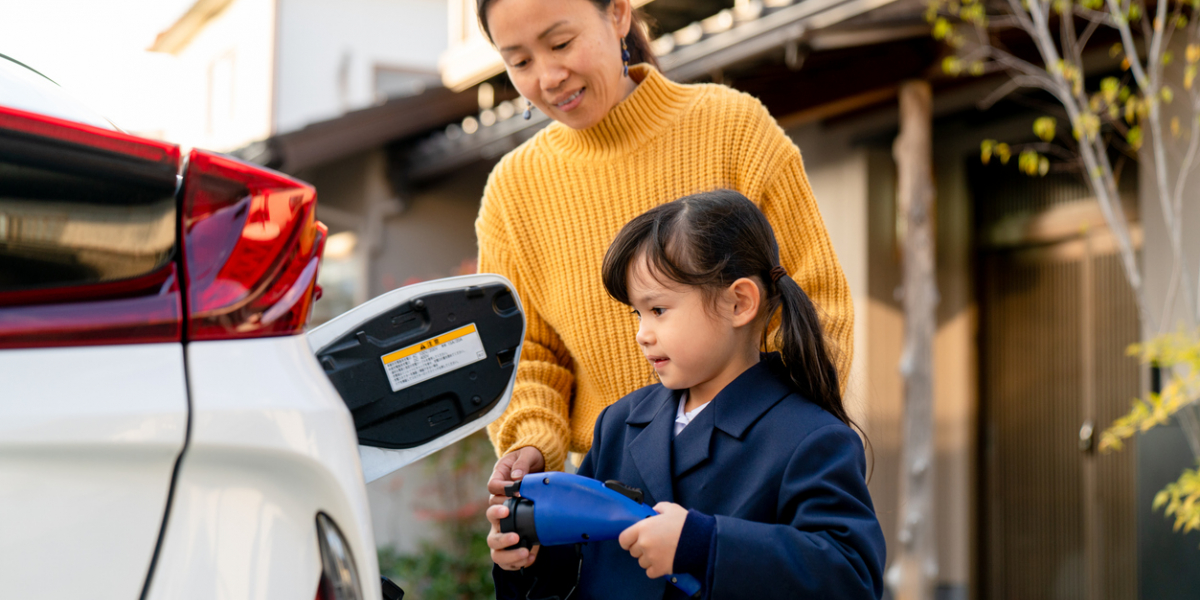
February 4, 2025
Electric vehicles (EVs) are an important part of decarbonizing transportation. But there are other benefits of EVs that are less known to consumers and they’re thanks to a feature called bidirectional charging. There are two types of bidirectional connections—vehicle-to-grid (V2G) and vehicle-to-home (V2H). V2G allows EV owners to draw power from the grid to charge their EV and feed power back into the grid from their EV when it’s plugged in. When there’s a power outage, EV owners with a V2H connection can power their homes from their EV.
Beyond these direct consumer benefits, the energy storage capacity of EV batteries can increase the overall stability and resiliency of the electrical grid. By as early as 2030, even if only 12 to 43% of EV owners charge their EV when electricity demand is low and sell the power back at peak times, batteries can substantially contribute to the grid’s resiliency. Using energy stored in EV batteries is also helpful in emergency situations and better for the environment than current options like diesel generators. However, changes in EV design, electrical grids and government policies are needed for all EV owners to have these abilities.
The current challenge is that only some EVs are able to charge bidirectionally and capture these benefits.
EVs with bidirectional charging abilities include the:
General Motors, Tesla, Volvo and Polestar have made promises to include bidirectional charging in their future EVs. According to BC Hydro, although bidirectional charging causes some discharge and energy loss of the EV, the amount is much less than when driving.
Companies should create solutions for their older EVs to enable V2G and V2H charging and make these features standard for all models and charging ports. They should also make sure their systems and protocols can be integrated with utilities across Canada.
For a long time, electrical grids have only needed to flow one way—from the power station to homes. Upgrades will be needed to ensure that grids across Canada are ready for the additional electricity demand that will be required for EV charging. They’ll also have to allow energy stored in an EV battery to flow back to the grid, like how residential solar power can be sold back to the grid when the sun is out.
Canada’s first V2G pilot project for medium- and heavy-duty vehicles happened at the end of 2023 in British Columbia, where a Lion Electric school bus was connected to the grid using a 60-kilowatt charger and could “power 24 single-family, electrically heated homes for almost two hours.” There is vast potential if the Government of Canada’s targets (1.4 million ZEVs on the road by 2026, rising to 4.6 million by 2030, and 12.4 million by 2035) all participate in bidirectional charging.
Lastly, government has a role in facilitating these changes as well. This could be making sure utilities give EV owners fair financial compensation to participate, or providing incentives like rebates to purchase an EV and install a home charger. Government could also develop standards, promote and potentially finance these technological innovations, and offer grants to upgrade electrical distribution services.
Announced in April of 2024, the Government of Ontario’s Grid Innovation Fund promised to invest $9.5 million on projects that will improve the efficiency of the province’s electricity system. V2G is a new technology Ontario is focusing on as a way to increase the flexibility, reliability and affordability of its grid. At the charger level, BC Hydro’s CleanBC Go Electric program offers rebates to install EV chargers at homes and workplaces. Rebates should include bidirectional charging technologies as well. Governments will also have to go through their existing policies to ensure nothing disincentivizes or is a bottleneck to bidirectional charging.
It is possible that as soon as 2030, our short-term daily grid storage demands could be supplied by just EV batteries. But first, companies must ensure all of their EVs have bidirectional charging abilities, the electrical grid must be ready, utilities will have to compensate consumers, and government will have to develop standards and review regulations. These changes and investments will make Canada’s electrical grid more resilient and will realize an additional benefit of EVs for Canadians and the environment.